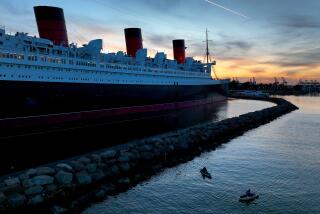Nassco Says Double-Hull Valdez Feasible
- Share via
Shipbuilders repairing the damaged tanker Exxon Valdez said Friday that it would have been structurally feasible to build a double hull for the single-skinned ship, but that Exxon Shipping Co. never requested an estimate.
Fred Hallett, vice president and chief financial officer of National Steel & Shipbuilding Co. (Nassco), disputed Exxon Shipping Co.’s claim that a double hull would put too much stress on the Valdez’s structure.
“A double hull retrofit is feasible on any ship. There’s nothing technically impossible about it,” he said, adding that he could not estimate the cost of such a project because, “Exxon did not ask us to do a cost estimate.”
Many shipping experts advocate equipping ships with double bottoms, or hulls, to prevent or reduce oil spills of the magnitude of the Valdez spill, which occurred nearly one year ago when rocks on Alaska’s Bligh Reef tore open the tanker’s hull. As a result, 11 million gallons of crude oil poured into Prince William Sound.
The Coast Guard has concluded that a double hull would have kept as much as 60% of that oil out of the water. Similarly, the New York-based Tanker Advisory Center, which issues safety ratings on the world’s tankers, has found that a double hull would have prevented the recent Huntington Beach spill, which dumped 400,000 gallons of crude off Orange County’s beaches.
Carrie Chassin, a spokeswoman for Exxon Shipping Co., said Friday that Exxon officials decided against retrofitting the Valdez with a double hull “for structural engineering reasons. Adding a double bottom to the existing structure would have increased the stresses on the structure of the ship,” Chassin said.
Instead, the 987-foot tanker is being restored to its original specifications. Hallett said the $30-million repair job, which began last August, is about 70% complete and the tanker should be released to Exxon in July, on schedule.
Chassin said the tanker could be hauling crude or processed oil again this summer, although Exxon has not yet determined what routes the ship will travel or whether it will sail under the name Valdez.
So far, most of the ship’s bottom has been rebuilt, with 15 100-ton steel segments placed side by side. Still to come is the repair of the damaged starboard side, where rusty scrapes and tears are still visible. Ten 100-ton steel plates will be set in place over the next four months, Hallett said.
The bow of the ship will be attached last, he said.
On an average day at the huge dry dock where the Valdez is berthed, about 300 pipe fitters, carpenters, electricians, welders and painters can be seen at work. When they are finished, Hallett said, he believes the repaired tanker will be as seaworthy as when Nassco first built it.
“The ship will have the structural strength and integrity that it had the day it left our yard,” he said.
More to Read
Sign up for Essential California
The most important California stories and recommendations in your inbox every morning.
You may occasionally receive promotional content from the Los Angeles Times.











